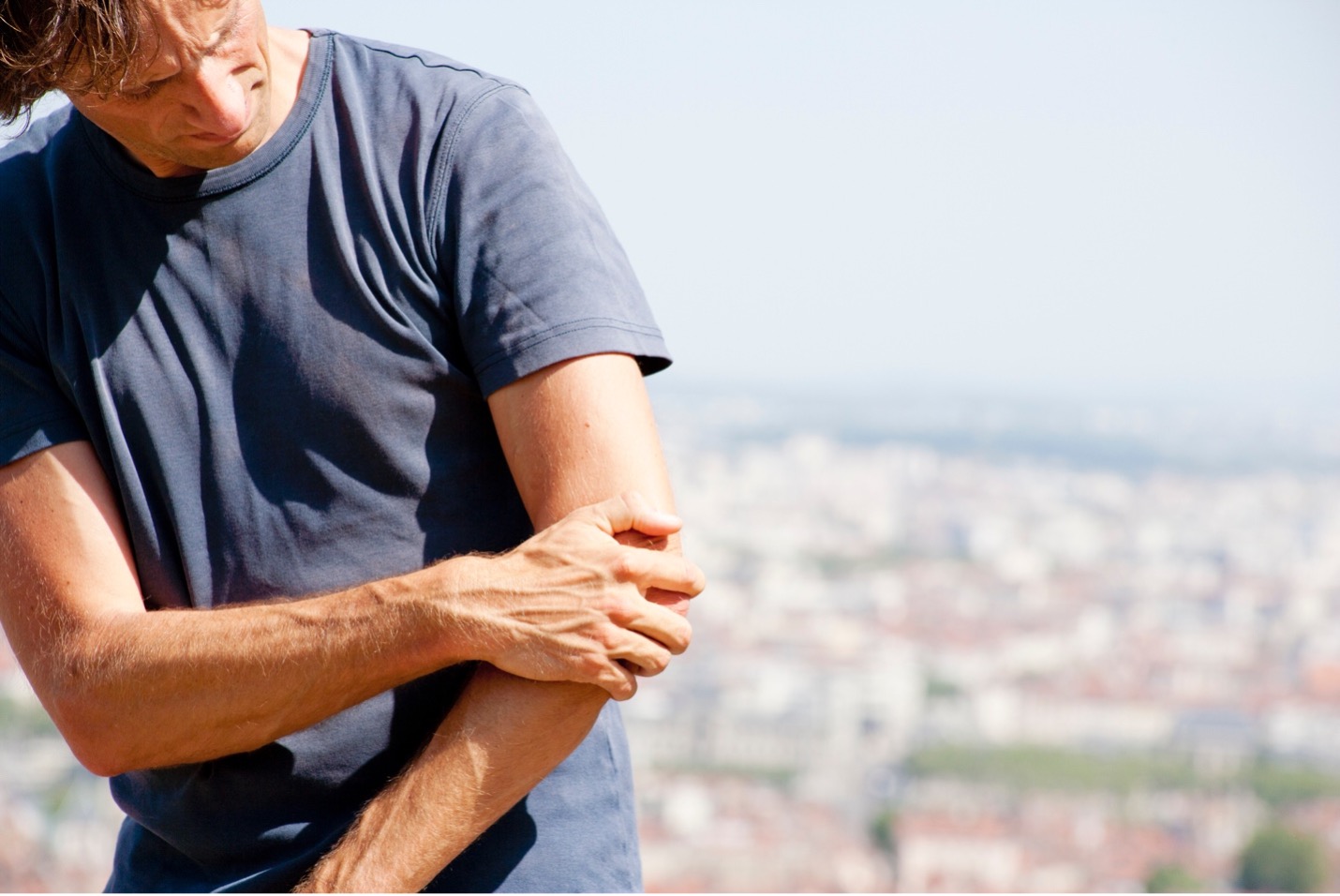Natural Joint & Pain Management Treatments for Tennis and Golfer’s Elbow
 Posted at Oct 2022
Posted at Oct 2022

Natural Joint & Pain Management Treatments for Tennis and Golfer’s Elbow
Tennis elbow and golfer’s elbow explained
Overuse and repetitive contractions of the muscles and tendons of the forearm and elbow can put too much strain on the elbow tendons causing maladaptations in tendon structure that lead to pain. Tennis elbow and golfer’s elbow are two of the most common elbow-related injuries. These injuries are often confused but they are quite different and each affects different tendons in the elbow. Tendons are a type of connective tissue made up primarily of strong collagenous fibers. However, they are not designed to stretch and extend. This makes the tendons in the elbow vulnerable to injury. Elbow tendinopathy represents an important set of pathologies that account for lost recreation time, decreased quality of life, and work-related disability claims.
Who is at risk for developing tennis elbow and golfer’s elbow?
Both conditions can be the result of the sport for which they are named, but a variety of activities can cause epicondylitis. Tennis elbow can result from any racquet sport but also professions including carpentry, painting, plumbing, cooking (cutting food), and repetitive computer mouse use. Those at risk for golfer’s elbow include baseball pitchers, painters, and those whose professions involve gripping and twisting motions (e.g., repetitive screwdriver use). Pitchers and overhead throwing athletes often develop the disease because of high energy forces to the elbow during the late cocking and acceleration phase. In golfers, it is thought to occur from the top of the backswing to just before ball impact. In tennis players, those using a one-handed backhand are particularly at risk. One study reports up to 50% of all recreational tennis players will develop tennis elbow1.
Overall, epicondylitis affects 1-3% of the population, is more common in women, and typically affects those between 35-64 years old. Epicondylitis predominantly occurs on the lateral rather than on the medial side of the joint, with a 4:1 to 7:1 ratio2. Importantly, more than 90% of cases are not sports-related. In fact, in certain occupations, the prevalence of epicondylitis may be as high as 3.8% to 8.2%. Obesity and smoking are considered independent risk factors for developing Tennis or Golfer’s Elbow.
Symptoms of tennis elbow and golfer’s elbow
Generally, pain around the lateral and medial elbow differentiate tennis elbow from golfer’s elbow, respectively. However, in both cases, the following symptoms may occur:
- Pain and tenderness that could radiate into the forearm and wrist and worsen with certain movements that include twisting, gripping, extension, or making a fist
- Weakness in the hands and wrists
- Stiffness in the elbow
- Numbness or tingling that might radiate into one or more fingers
With mild injury, both conditions may self-resolve, eventually disappearing when the activity causing the pain ceases. However, these conditions can become chronic when the activity responsible for the injury continues over time.
Pathophysiology of tennis elbow and golfer’s elbow
The elbow joint is made up of three bones: the humerus (upper arm bone), the radius, and the ulna (two bones in the forearm). At the distal end of the humerus nearest the elbow, there are two epicondyles, one lateral (on the outside) and one medial (on the inside). These are enlarged regions of the humerus where tendons connecting the muscles of the forearm attach to the humerus. The lateral and medial epicondyle is the common origin of the extensor and flexor muscles of the forearm, respectively.
Tennis elbow involves injury to the common extensor tendon that originates from the lateral epicondyle of the elbow. Several forearm muscles come together to form the common extensor tendon. Repeated overloading of these muscles can lead to tendinopathy.
Golfer’s elbow is tendinopathy of the medial common flexor tendon of the elbow. Together, the pronator teres, flexor carpi radialis, palmaris longus, and flexor digitorum superficialis form the common flexor tendon which originates from the medial epicondyle of the humerus.
In athletes, training errors, improper technique, equipment, or functional risk factors, including lack of strength, endurance, or flexibility are all factors that can lead to lateral and medial epicondylitis2. Inflammation and tearing of the tendons at the epicondyles are main cause of pain in tennis and golfer’s elbow.
As mentioned above, it is the chronic repetitive loading of the forearm muscles and wrist that results in degeneration of the tendon due to decreased blood flow and damage to the collagenous fibers that make up the tendon. Repetitive activity leads to recurrent microtears within the tendon and subsequent tendinosis. As the tendon undergoes repetitive microtears, there is remodeling of the collagen fibers, focal necrosis (tissue death) and calcification. Subsequently, collagen strength decreases leading to increased fragility, scar tissue formation, and thickening of the tendon which causes significant and potentially debilitating pain. Although less common, acute trauma can also cause epicondylitis from a sudden violent contraction of the muscles.
Conventional treatments for tennis elbow and golfer’s elbow
Tennis and golfer’s elbow require medical attention as soon as the symptoms appear. Early attention usually prevents the development of a serious disorder. The most important steps in treatment include:
- Rest from the activities that cause elbow pain
- Correction of incorrect technique, form, postures, and motions
- Medication, such as oral or topical non-steroidal anti-inflammatory drugs (NSAIDS) to reduce the inflammation or pain
- Exercises to stretch and strengthen muscles
- Physiotherapy to assess the healing process and restore the elbow function
- Corticosteroid (cortisone) injections (may have significant side effects)
Surgical intervention for tennis elbow and golfer’s elbow
If these remedies fail to resolve the pain, then diagnostic imaging such as ultrasound or MRI may be used to determine if surgical intervention is needed to repair the damaged tendon. Typically, 6-12 months of conventional treatment is undertaken before surgery is considered. The downtime from surgery is approximately 6-12 weeks. During this time, exercises are recommended to restore range of motion and strength, but 4-6 months are needed before exercise and sporting activities can be resumed. Unfortunately, many patients do not return to their previous recreational sporting activities. Possible complications related to surgery are: infection, damage to nerves or blood vessels in the elbow, and reduced strength or flexibility.
Natural joint & back pain management treatments for tennis elbow and golfer’s elbow
The field of natural joint & back pain management has revolutionized the treatment of osteoarthritic and sports-related bone and joint injuries. A growing number of professional athletes, such as Rafael Nadal and Tiger Woods, are turning to these treatments before considering surgery. The advantages of natural joint & back pain management treatments are:
- Little to no downtime due to the procedure
- Results can be boosted with physical therapy
- No side effects from pharmaceutical and cortisone drug therapies
- Healing of the injury versus masking the pain of cortisone injections
- All-natural treatments to help avoid surgery
To learn more about natural methods for treating tennis and golfer’s elbow, contact the Spark Health wellness clinic. Located in Solana Beach, CA, our practitioners will spend time evaluating how the internal and external parts of your body interact in order to develop a comprehensive care plan that is specifically designed to address your biggest health needs. Contact us to schedule an initial appointment!
Article written by the Spark Natural Pain Management Team








